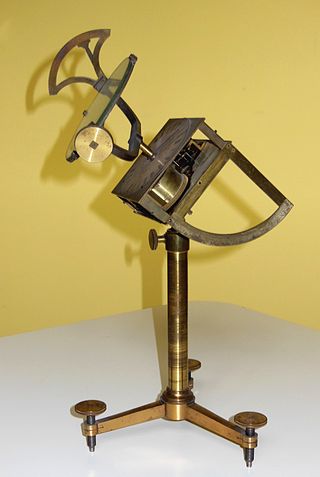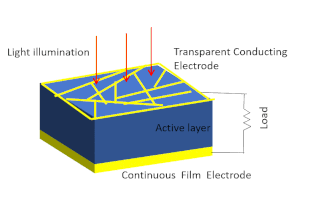Related Research Articles

Solar energy is radiant light and heat from the Sun that is harnessed using a range of technologies such as solar power to generate electricity, solar thermal energy, and solar architecture. It is an essential source of renewable energy, and its technologies are broadly characterized as either passive solar or active solar depending on how they capture and distribute solar energy or convert it into solar power. Active solar techniques include the use of photovoltaic systems, concentrated solar power, and solar water heating to harness the energy. Passive solar techniques include orienting a building to the Sun, selecting materials with favorable thermal mass or light-dispersing properties, and designing spaces that naturally circulate air.

Solar sails are a method of spacecraft propulsion using radiation pressure exerted by sunlight on large surfaces. A number of spaceflight missions to test solar propulsion and navigation have been proposed since the 1980s. The first spacecraft to make use of the technology was IKAROS, launched in 2010.

In passive solar building design, windows, walls, and floors are made to collect, store, reflect, and distribute solar energy, in the form of heat in the winter and reject solar heat in the summer. This is called passive solar design because, unlike active solar heating systems, it does not involve the use of mechanical and electrical devices.

A ball mill is a type of grinder used to grind or blend materials for use in mineral dressing processes, paints, pyrotechnics, ceramics, and selective laser sintering. It works on the principle of impact and attrition: size reduction is done by impact as the balls drop from near the top of the shell.

A heliostat is a device that includes a mirror, usually a plane mirror, which turns so as to keep reflecting sunlight toward a predetermined target, compensating for the Sun's apparent motions in the sky.

A solar mirror contains a substrate with a reflective layer for reflecting the solar energy, and in most cases an interference layer. This may be a planar mirror or parabolic arrays of solar mirrors used to achieve a substantially concentrated reflection factor for solar energy systems.

A solar cooker is a device which uses the energy of direct sunlight to heat, cook or pasteurize drink and other food materials. Many solar cookers currently in use are relatively inexpensive, low-tech devices, although some are as powerful or as expensive as traditional stoves, and advanced, large scale solar cookers can cook for hundreds of people. Because they use no fuel and cost nothing to operate, many nonprofit organizations are promoting their use worldwide in order to help reduce fuel costs and air pollution, and to help slow down deforestation and desertification.

Space manufacturing is the production of tangible goods beyond Earth. Since most production capabilities are limited to low Earth orbit, the term in-orbit manufacturing is also frequently used.
Solar chemical refers to a number of possible processes that harness solar energy by absorbing sunlight in a chemical reaction. The idea is conceptually similar to photosynthesis in plants, which converts solar energy into the chemical bonds of glucose molecules, but without using living organisms, which is why it is also called artificial photosynthesis.

A solar panel is a device that converts sunlight into electricity by using photovoltaic (PV) cells. PV cells are made of materials that produce excited electrons when exposed to light. The electrons flow through a circuit and produce direct current (DC) electricity, which can be used to power various devices or be stored in batteries. Solar panels are also known as solar cell panels, solar electric panels, or PV modules.

Solar-powered pumps run on electricity generated by photovoltaic (PV) panels or the radiated thermal energy available from collected sunlight as opposed to grid electricity- or diesel-run water pumps. Generally, solar-powered pumps consist of a solar panel array, solar charge controller, DC water pump, fuse box/breakers, electrical wiring, and a water storage tank. The operation of solar-powered pumps is more economical mainly due to the lower operation and maintenance costs and has less environmental impact than pumps powered by an internal combustion engine. Solar pumps are useful where grid electricity is unavailable or impractical, and alternative sources do not provide sufficient energy.

Spacecraft operating in the inner Solar System usually rely on the use of power electronics-managed photovoltaic solar panels to derive electricity from sunlight. Outside the orbit of Jupiter, solar radiation is too weak to produce sufficient power within current solar technology and spacecraft mass limitations, so radioisotope thermoelectric generators (RTGs) are instead used as a power source.

Light tubes are structures that transmit or distribute natural or artificial light for the purpose of illumination and are examples of optical waveguides.

A solar car is a solar vehicle for use on public roads or race tracks. Solar vehicles are electric vehicles that use self-contained solar cells to provide full or partial power to the vehicle via sunlight. Solar vehicles typically contain a rechargeable battery to help regulate and store the energy from the solar cells and from regenerative braking. Some solar cars can be plugged into external power sources to supplement the power of sunlight used to charge their battery.

Solar architecture is an architectural approach that takes in account the Sun to harness clean and renewable solar power. It is related to the fields of optics, thermics, electronics and materials science. Both active and passive solar housing skills are involved in solar architecture.

Solar-cell efficiency refers to the portion of energy in the form of sunlight that can be converted via photovoltaics into electricity by the solar cell.
A photovoltaic keyboard, or solar keyboard, is a wireless computer keyboard that charges its batteries from a light source such as the sun or interior lighting, addressing a major drawback of wireless computer peripherals that otherwise require regular replacement of discharged batteries.

Solar powered flashlights or solar powered torches are flashlights powered by solar energy stored in rechargeable batteries. Most of these flashlights use light-emitting diodes lamps since they have lower energy consumption compared to incandescent light bulbs.
The following outline is provided as an overview of and topical guide to solar energy:

This is an alphabetized glossary of terms pertaining to lighting fires, along with their definitions. Firelighting is the process of starting a fire artificially. Fire was an essential tool in early human cultural development. The ignition of any fire, whether natural or artificial, requires completing the fire triangle, usually by initiating the combustion of a suitably flammable material.